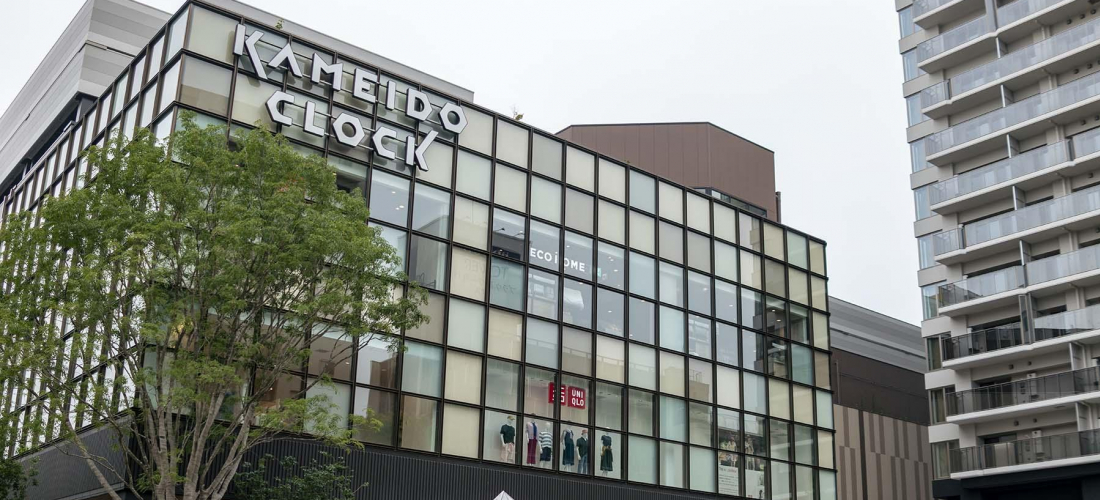CONTENTS
Ameyoko has been Ueno’s most lively shopping destination for decades on end, but do you know what to check out during your next visit?
What & Where Is Ameyoko?
Ueno has been a busy neighborhood of Tokyo for hundreds of years, since the days when it was part of the Edo's Shitamachi, where you might have found fewer samurai, but more merchants, craftspeople, and general trade. To this day, the cluster of narrow pedestrian streets between Ueno and Okachimachi train stations is a center of commerce, and at the heart of it all is Ameyoko, a shopping street that follows the JR train tracks rumbling overhead. Formerly known as "Ameya Yokocho" (but usually referred to by its shortened nickname), Ameyoko is a bustling market that packs a lot into the 400-meter (quarter-mile) stretch south of Ueno Station, lined with drugstores and souvenir shops, stores selling practical daily necessities and groceries, stores selling items you can't imagine anyone ever buying, tiny stalls and restaurants with flimsy outdoor seating, and much more. Like so much of Tokyo, this busy marketplace sprang up in the bombed ruins of a previous shopping and residential area during the postwar period, but it has prospered in the decades since, evolving into the shopping and sightseeing destination we know today. Between the crowds, and all the sounds, smells, and sights, it's easy to wander along Ameyoko for hours, but if your wallet is burning a hole in your pocket and you're ready to shop, here's what to look for!
➡ Ameyoko Classics: Candy & Army Surplus!?
There are a couple different origin stories for the name Ameya Yokocho (アメヤ横丁), and both stem from the goods available in the market after WWII. The word "yokocho" simply means alley or side street, and "ya" refers to some kind of shop, but why "ame"? Some say it's a reference to the candy, ame (飴) in Japanese, that was surprisingly plentiful at the market despite the severe sugar shortages of the period. Others will tell you that ame is short for "American," referring to the US army surplus sold after the war. Either way, both of these are still available in Ameyoko to these days, so shopping for them is just about the most authentic Ameyoko experience you can make for yourself! Shops scattered along the street and down neighboring alleys have displays of rugged-looking backpacks and full camo outfits, although it's not always clear which of these shops sell actual army surplus, and which are just going for a certain style. And when it comes to candy, Ameyoko has both large multi-building sweets shops like Niki no Kashi and also plenty of much smaller shops and counters specializing in sweet treats. There are traditional Japanese wagashi (和菓子) made with red bean and matcha, Japan's beloved retro candies and snacks referred to as dagashi (駄菓子), and of course modern Japanese favorites like flavored Kit Kats! Sweet tooths, rejoice!
➡ Ueno Fashion: High-Quality Denim & Shitamachi Styles
In-the-know fashion experts will tell you that Ameyoko is actually a must-see spot for anyone who loves Japanese denim, as the market has long been a shopping destination for denim in Tokyo. Hinoya – a shop still found on the opposite side of the train tracks – began selling military surplus in Ameyoko in 1949, and by the 70s, the shop had expanded to include American products like Levi's jeans. These days, at Hinoya and other shops nearby, American brands are found on the shelves alongside the Japanese brands that have become known internationally for making some of the best jeans and denim products around, which means that shoppers can stop by Ueno to pick up items from brands like Momotaro Jeans, Oni Denim, and Blue Blue, instead of having to travel all the way to the manufacturing sites in Okayama.
The clothing in Ameyoko isn't all top-tier high-quality denim, though. In the days of samurai, Ueno was a neighborhood for lower castes, part of the Shitamachi, and it still has its own down-to-earth kind of style. Clothing shoppers browsing the wares along Ameyoko aren't going to find Louis Vuitton opening up a shop any time soon, but there are plenty of shops selling jackets embroidered with colorful dragons, demons, and anime characters, or t-shirts with Japanese puns scrawled across the chest, and maybe some classy muumuus catering to Ueno's older crowd. For those with a more eclectic style, you might find the perfect thing to complete your look hanging on a display over Ameyoko.
➡ Tempt Your Tastebuds Under the Traintracks: Izakaya & International Eats
Finally, the first thing any shopper is likely to notice along Ameyoko is the food, and there's a lot of it. Those who are in Tokyo long-term might find themselves greedily eyeing the bulk prices of enormous bags of green tea and sacks of dried goods, and many of Tokyo's foreign residents flock to the international grocers both above and below ground, many of which offer unusual Asian ingredients. Displays spill out in front of the many little stores, showing off packaged goods, fresh fruit, and anything else you might want to stock up on. (Locals will tell you that the fresh fish sitting out at these groceries comes a little less highly recommended, though.)
For sightseers and locals looking for a snack, spots all along the street specialize in quick bites from all over Japan (and all over the world)! Grab a slice of melon on a stick, a dish of Korean fried chicken, a little bamboo boat filled with takoyaki, and wash it all down with some bubble tea – usually just called "tapioca" in Japan. On the other hand, after a long day walking around Ueno many people choose to sit down at one of the neighborhood's many popular izakaya. These eateries run on draft beer, whisky-sodas, and yakitori – grilled skewers stacked with juicy chicken thigh, flavorful meatballs, tender chicken hearts, and crunchy cartilage. Picky eaters will be just fine, but for anyone with an adventurous palate, well, the narrow alleys of Ueno beckon!
Once a ramshackle postwar marketplace, the Ameyoko of today has tons of history, plenty of retro charm, a little bit of modern flair, and enough shopping to keep you entertained all day. So whether you're looking for the kind of Japanese candy that made Ameyoko popular, the unique Ueno fashion that has kept shoppers coming for decades, or just a bite to eat and a fun night out on the town, don't forget to stop by Ameyoko!
Details
NAME:Ameyoko (アメ横)
ACCESS:Ueno Station (上野駅) or Okachimachi Station (御徒町駅)
Looking for the latest trends and products coming out of Japan? We've got you covered!
COMMENT
FEATURED MEDIA
VIEW MORE 
A New Tokyo Animal Destination: Relax & Learn About the World’s Animals in Japan
#pr #japankuru #anitouch #anitouchtokyodome #capybara #capybaracafe #animalcafe #tokyotrip #japantrip #카피바라 #애니터치 #아이와가볼만한곳 #도쿄여행 #가족여행 #東京旅遊 #東京親子景點 #日本動物互動體驗 #水豚泡澡 #東京巨蛋城 #เที่ยวญี่ปุ่น2025 #ที่เที่ยวครอบครัว #สวนสัตว์ในร่ม #TokyoDomeCity #anitouchtokyodome

Shohei Ohtani Collab Developed Products & Other Japanese Drugstore Recommendations From Kowa
#pr #japankuru
#kowa #syncronkowa #japanshopping #preworkout #postworkout #tokyoshopping #japantrip #일본쇼핑 #일본이온음료 #오타니 #오타니쇼헤이 #코와 #興和 #日本必買 #日本旅遊 #運動補充能量 #運動飲品 #ช้อปปิ้งญี่ปุ่น #เครื่องดื่มออกกำลังกาย #นักกีฬา #ผลิตภัณฑ์ญี่ปุ่น #อาหารเสริมญี่ปุ่น

도쿄 근교 당일치기 여행 추천! 작은 에도라 불리는 ‘가와고에’
세이부 ‘가와고에 패스(디지털)’ 하나면 편리하게 이동 + 가성비까지 완벽하게! 필름카메라 감성 가득한 레트로 거리 길거리 먹방부터 귀여움 끝판왕 핫플&포토 스폿까지 총집합!
Looking for day trips from Tokyo? Try Kawagoe, AKA Little Edo!
Use the SEIBU KAWAGOE PASS (Digital) for easy, affordable transportation!
Check out the historic streets of Kawagoe for some great street food and plenty of picturesque retro photo ops.
#pr #japankuru #도쿄근교여행 #가와고에 #가와고에패스 #세이부패스 #기모노체험 #가와고에여행 #도쿄여행코스 #도쿄근교당일치기 #세이부가와고에패스
#tokyotrip #kawagoe #tokyodaytrip #seibukawagoepass #kimono #japantrip

Hirakata Park, Osaka: Enjoy the Classic Japanese Theme Park Experience!
#pr #japankuru #hirakatapark #amusementpark #japantrip #osakatrip #familytrip #rollercoaster #retrôvibes #枚方公園 #大阪旅遊 #關西私房景點 #日本親子旅行 #日本遊樂園 #木造雲霄飛車 #히라카타파크 #สวนสนุกฮิราคาตะพาร์ค

🍵Love Matcha? Upgrade Your Matcha Experience With Tsujiri!
・160년 전통 일본 말차 브랜드 츠지리에서 말차 덕후들이 픽한 인기템만 골라봤어요
・抹茶控的天堂!甜點、餅乾、飲品一次滿足,連伴手禮都幫你列好清單了
・ส่องมัทฉะสุดฮิต พร้อมพาเที่ยวร้านดังในอุจิ เกียวโต
#pr #japankuru #matcha #matchalover #uji #kyoto #japantrip #ujimatcha #matchalatte #matchasweets #tsujiri #말차 #말차덕후 #츠지리 #교토여행 #말차라떼 #辻利抹茶 #抹茶控 #日本抹茶 #宇治 #宇治抹茶 #日本伴手禮 #抹茶拿鐵 #抹茶甜點 #มัทฉะ #ของฝากญี่ปุ่น #ชาเขียวญี่ปุ่น #ซึจิริ #เกียวโต

・What Is Nenaito? And How Does This Sleep Care Supplement Work?
・你的睡眠保健品——認識「睡眠茶氨酸錠」
・수면 케어 서플리먼트 ‘네나이토’란?
・ผลิตภัณฑ์เสริมอาหารดูแลการนอน “Nenaito(ネナイト)” คืออะไร?
#pr #japankuru #sleepcare #japanshopping #nenaito #sleepsupplement #asahi #睡眠茶氨酸錠 #睡眠保健 #朝日 #l茶胺酸 #日本藥妝 #日本必買 #일본쇼핑 #수면 #건강하자 #네나이토 #일본영양제 #อาหารเสริมญี่ปุ่น #ช้อปปิ้งญี่ปุ่น #ร้านขายยาญี่ปุ่น #ดูแลตัวเองก่อนนอน #อาซาฮิ

Japanese Drugstore Must-Buys! Essential Items from Hisamitsu® Pharmaceutical
#PR #japankuru #hisamitsu #salonpas #feitas #hisamitsupharmaceutical #japanshopping #tokyoshopping #traveltips #japanhaul #japantrip #japantravel

Whether you grew up with Dragon Ball or you just fell in love with Dragon Ball DAIMA, you'll like the newest JINS collab. Shop this limited-edition Dragon Ball accessory collection to find some of the best Dragon Ball merchandise in Japan!
>> Find out more at Japankuru.com! (link in bio)
#japankuru #dragonball #dragonballdaima #animecollab #japanshopping #jins #japaneseglasses #japantravel #animemerch #pr

This month, Japankuru teamed up with @official_korekoko to invite three influencers (originally from Thailand, China, and Taiwan) on a trip to Yokohama. Check out the article (in Chinese) on Japankuru.com for all of their travel tips and photography hints - and look forward to more cool collaborations coming soon!
【橫濱夜散策 x 教你怎麼拍出網美照 📸✨】
每次來日本玩,是不是都會先找旅日網紅的推薦清單?
這次,我們邀請擁有日本豐富旅遊經驗的🇹🇭泰國、🇨🇳中國、🇹🇼台灣網紅,帶你走進夜晚的橫濱!從玩樂路線到拍照技巧,教你怎麼拍出最美的夜景照。那些熟悉的景點,換個視角說不定會有新發現~快跟他們一起出發吧!
#japankuru #橫濱紅磚倉庫 #汽車道 #中華街 #yokohama #japankuru #橫濱紅磚倉庫 #汽車道 #中華街 #yokohama #yokohamaredbrickwarehouse #yokohamachinatown

If you’re a fan of Vivienne Westwood's Japanese designs, and you’re looking forward to shopping in Harajuku this summer, we’ve got important news for you. Vivienne Westwood RED LABEL Laforet Harajuku is now closed for renovations - but the grand reopening is scheduled for July!
>> Find out more at Japankuru.com! (link in bio)
#japankuru #viviennewestwood #harajuku #omotesando #viviennewestwoodredlabel #viviennewestwoodjapan #비비안웨스트우드 #오모테산도 #하라주쿠 #日本購物 #薇薇安魏斯伍德 #日本時尚 #原宿 #表參道 #japantrip #japanshopping #pr

Ready to see TeamLab in Kyoto!? At TeamLab Biovortex Kyoto, the collective is taking their acclaimed immersive art and bringing it to Japan's ancient capital. We can't wait to see it for ourselves this autumn!
>> Find out more at Japankuru.com! (link in bio)
#japankuru #teamlab #teamlabbiovortex #kyoto #kyototrip #japantravel #artnews
Photos courtesy of teamLab, Exhibition view of teamLab Biovortex Kyoto, 2025, Kyoto ® teamLab, courtesy Pace Gallery

Japanese Makeup Shopping • A Trip to Kamakura & Enoshima With Canmake’s Cool-Toned Summer Makeup
#pr #canmake #enoshima #enoden #에노시마 #캔메이크 #japanesemakeup #japanesecosmetics

⚔️The Robot Restaurant is gone, but the Samurai Restaurant is here to take its place. Check it out, and don't forget your coupon!
🍣신주쿠의 명소 로봇 레스토랑이 사무라이 레스토랑으로 부활! 절찬 쿠폰 발급중
💃18歲以上才能入場的歌舞秀,和你想的不一樣!拿好優惠券去看看~
#tokyo #shinjuku #samurairestaurant #robotrestaurant #tokyotrip #도쿄여행 #신주쿠 #사무라이레스토랑 #이색체험 #할인이벤트 #歌舞伎町 #東京景點 #武士餐廳 #日本表演 #日本文化體驗 #japankuru #japantrip #japantravel #japanlovers #japan_of_insta

Japanese appliance & electronics shopping with our KOJIMA x BicCamera coupon!
用JAPANKURU的KOJIMA x BicCamera優惠券買這些正好❤️
코지마 x 빅 카메라 쿠폰으로 일본 가전 제품 쇼핑하기
#pr #japankuru #japanshopping #kojima #biccamera #japaneseskincare #yaman #dji #osmopocket3 #skincaredevice #日本購物 #美容儀 #相機 #雅萌 #日本家電 #일본여행 #면세 #여행꿀팁 #일본쇼핑리스트 #쿠폰 #일본쇼핑 #일본브랜드 #할인 #코지마 #빅카메라 #japankurucoupon






















































